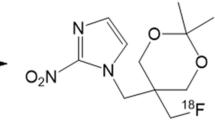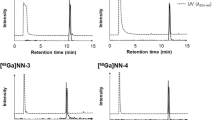Abstract
62Cu labeled diacetyl-bis(N4-methylthiosemicarbazone) (62Cu-ATSM) has been proposed as a generator-produced, positron-emitting tracer for hypoxic tissue imaging. From basic studies, the retention mechanism of62Cu-ATSM is considered to be closely related to cytosolic/microsomal bioreduction, a possible system for hypoxic bioreductive drug activation. In order to evaluate the characteristics of62Cu-ATSM, PET studies were performed in 4 normal subjects and 6 patients with lung cancer.62Cu-ATSM cleared rapidly from the blood with little lung uptake (0.43±0.09, uptake ratio; divided by the arterial input function) in normal subjects. Intense tumor uptake of62Cu-ATSM was observed in all patients with lung cancer (3.00±1.50). A negative correlation was observed between blood flow and flow-normalized62Cu-ATSM uptake in three of four patients. In contrast,62Cu-ATSM uptake was not related to that of18F-fluorodeoxyglucose. The negative correlation between blood flow and flow normalized62Cu-ATSM uptake suggests an enhancement of retention of62Cu-ATSM by low flow.62Cu-ATSM is a promising PET tracer for tumor imaging, which might bring new information for chemotherapeutic treatment as well as radiotherapy of hypoxic tumors.
Similar content being viewed by others
References
Coleman CN. Hypoxia in tumors: A paradigm for the approach to biochemical and physiological heterogeneity.J Natl Cancer Inst 80: 310–317, 1998.
Teicher BA, Lazo JS, Sartorelli AC. Classification of antineoplastic agents by their selective toxicities toward oxygenated and hypoxic tumor cells.Cancer Res 41(1): 73–81, 1981.
Chapman JD, Baer K, Lee J. Characteristics of the metabolism-induced binding of misonidazole to hypoxic mammalian cells.Cancer Res 43: 1523–1528, 1983.
Jerabek PA, Patrick TB, Kilbourn MR, Dischino DD, Welch MJ. Synthesis and biodistribution of18F-labeled fluoromisonidazoles: potentialin vivo markers of hypoxic tissue.Int J Radiate App Instrum [A] 37: 599–605, 1986.
Mannan RH, Somayaji VV, Lee J, Mercer JR, Chapman JD, Wiebe LI. Radiolabeled 1-(5-iodo-5-deoxy-β-d-arabinofuranosyl)-2-nitroimidazole (iodoazomycin arabinoside: IAZA): a novel marker of tissue hypoxia.J Nucl Med 32: 1764–1770, 1991.
Linder KE, Chan YW, Cyr JE, Malley MF, Nowotnik DP, Nunn AD. Technetium-O(PnAO-(2-nitroimidazole)) [BMS181321], a new technetium-containing nitroimidazole complex for imaging hypoxia: synthesis characterization and xanthine oxidase-catalyzed reduction.J Med Chem 37: 9–17, 1994.
Koh WJ, Rasey JS, Evans ML, Grierson JR, Lewellen TK, Graham MM, et al. Imaging of hypoxia in human tumors with [F-18]fluoromisonidazole.Int J Radiate Once Biol Phys 22: 199–212, 1992.
Fujibayashi Y, Taniuchi H, Yonekura Y, Ohtani H, Konishi J, Yokoyama A. Copper-62-ATSM: a new hypoxia imaging agent with high membrane permeability and low redox potential.J Nucl Med 38: 1155–1160, 1997.
Fujibayashi Y, Taniuchi H, Wada A, Yonekura Y, Konishi J, Yokoyama A. Differential mechanism of retention of Cupyruvaldehyde-bis(N 4-methylthiosemicarbazone) (Cu-PTSM) by brain and tumor: a novel radiopharmaceutical for positron emission tomography imaging.Ann Nucl Med 9: 1–5, 1995.
Wada K, Fujibayashi Y, Tajima N, Yokoyama A. Cu-ATSM, an intracellular-accessible superoxide dismutase (SOD)-like copper complex: evaluation in an ischemia-reperfusion injury model.Biol Pharm Bull 17: 701–704, 1994.
Lewis JS, McCarthy DW, McCarthy TJ, Fujibayashi Y, Welch MJ. Evaluation of64Cu-ATSMin vitro andin vivo in a hypoxic tumor model.J Nucl Med 40: 177–183, 1999.
Matsumoto K, Fujibayashi Y, Yonekura Y. Application of the new zinc-62/copper-62 generator: an effective labeling method for62Cu-PTSM.Nucl Med Biol 19: 39–44, 1992.
Gingas BA, Suprunchuk T, Bayley CH. The preparation of some thiosemicarbazones and their copper complexes. Part III.Can J Chem 40: 1053–1059, 1962.
DeGrado TR, Turkington, TG, Williams JJ, Stearns CW, Hoffman JM, Coleman RE. Performance characteristics of a whole-body PET scanner.J Nucl Med 35: 1398–1406. 1994.
Herscovitch P, Markham J, Raichle ME. Brain blood flow measured with intravenous H2 16O. I. theory and error analysis.J Nucl Med 24: 782–789, 1983.
Raichle ME, Martin WRW, Herscovitch P, Mintun MA, Markham J. Brain blood flow measured with intravenous H2 15O. II. implementation and validation.J Nucl Med 24: 790–798, 1983.
Meyer E. Simultaneous correction for tracer arrival delay and dispersion in CBF measurements by the H2 15O autoradiographic method and dynamic PET.J Nucl Med 30: 1069–1078, 1989.
Fujibayashi Y, Yoshimi E, Waki A, Takahashi N, Yonekura Y. Cu-ATSM, a new tumor agent predicting ability for bioreductive drug activation.J Nucl Med 39 (suppl): 90P, 1998. [abstract]
Author information
Authors and Affiliations
Corresponding author
Rights and permissions
About this article
Cite this article
Takahashi, N., Fujibayashi, Y., Yonekura, Y. et al. Evaluation of62Cu labeled diacetyl-bis(N 4-methylthiosemicarbazone) as a hypoxic tissue tracer in patients with lung cancer. Ann Nucl Med 14, 323–328 (2000). https://doi.org/10.1007/BF02988690
Received:
Revised:
Issue Date:
DOI: https://doi.org/10.1007/BF02988690




